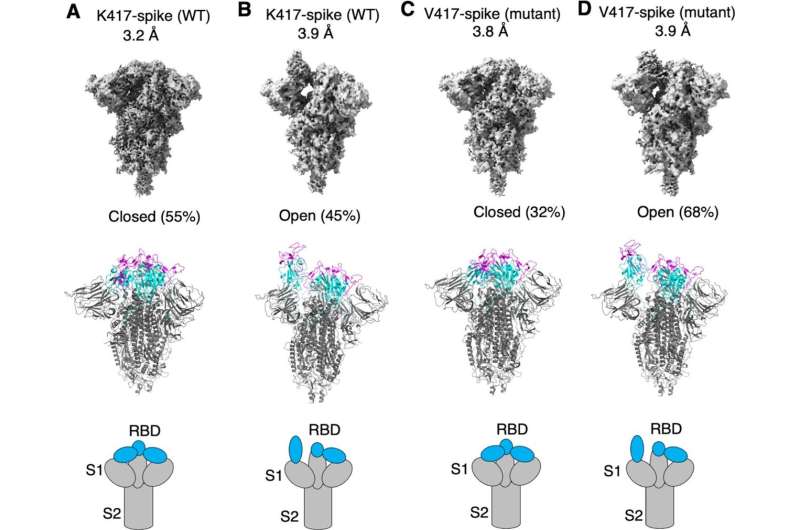This article has been reviewed according to Science X's editorial process and policies. Editors have highlighted the following attributes while ensuring the content's credibility:
fact-checked
peer-reviewed publication
trusted source
proofread
New study highlights COVID-19's adaptive strategy for infection

Researchers have discovered a novel mechanism whereby the SARS-CoV-2 virus, which causes COVID-19, can vary its mode of infection in human cells. In work published in the journal eLife, a team from the University of Minnesota and the Midwest Antiviral Drug Discovery (AViDD) Center found the virus can alternate between being highly infectious and avoiding detection by the immune system. This understanding is vital for grasping the virus' impact during the pandemic and for predicting its potential evolutionary developments.
The spike protein of the virus, which is crucial for attaching to and infecting human cells, includes a flexible section known as the receptor-binding domain (RBD). Fang Li, Ph.D., and his team at the University of Minnesota made an early breakthrough in the pandemic, finding the RBD of SARS-CoV-2 doesn't always remain in an accessible, "ready to connect" state. They proposed that the capacity of the RBD to alter its configuration permits the virus to either unveil itself for binding with human cells or shield itself from the immune system's antibodies.
In their recent research, scientists examined the variances between SARS-CoV-2 and its relative, the SARS-CoV-1 virus responsible for the SARS outbreak from 2002 to 2003. They pinpointed a particular area of the spike protein that determines the configuration of the RBD. Variations in this segment can shift the virus toward a more infectious state by opening up, or a more elusive state by closing off.
"When a novel coronavirus first emerges in humans, it often encounters minimal immune resistance and tends to be highly infectious," explained Dr. Li, a professor and endowed chair of pharmacology at the U of M Medical School and co-director of the Midwest AViDD Center. "As immunity develops among people, whether through infection or vaccination, the virus may increasingly resort to more elusive strategies to remain undetected. We have come to understand how a coronavirus can accomplish this evolution."
Li added that SARS-CoV-2 was particularly notable for its ability to strike a balance between high transmissibility and the capacity to evade the immune system from the outset of the pandemic.
At the Midwest AViDD Center, Dr. Li's team is also working on innovative treatments using nanobodies—tiny antibodies derived from animals like alpacas—that can target SARS-CoV-2 even when it's in "stealth mode." The study indicates these nanobodies have a significant advantage over conventional human antibodies in detecting and neutralizing SARS-CoV-2.
The research was co-led by Dr. Li and Bin Liu, Ph.D., associate professor at The Hormel Institute and investigator of the Midwest AViDD Center, with important contributions from postdoctoral pharmacology researchers Qibin Geng and Yushun Wan.
More information: Qibin Geng et al, Lys417 acts as a molecular switch that regulates the conformation of SARS-CoV-2 spike protein, eLife (2023). DOI: 10.7554/eLife.74060


















